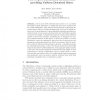Free Online Productivity Tools
i2Speak
i2Symbol
i2OCR
iTex2Img
iWeb2Print
iWeb2Shot
i2Type
iPdf2Split
iPdf2Merge
i2Bopomofo
i2Arabic
i2Style
i2Image
i2PDF
iLatex2Rtf
Sci2ools
91
Voted
OTM
2005
Springer
2005
Springer
Peer-to-Peer Distribution Architectures Providing Uniform Download Rates
Peer-to-peer (P2P) networks have proved to be a powerful and highly scalable alternative to traditional client-server architectures for content distribution. They offer the technical means to efficiently distribute data to millions of clients simultaneously with very low infrastructural cost. Previous studies of content distribution architectures have primarily focused on homogeneous systems where the bandwidth capacities of all peers are similar, or simple heterogeneous scenarios where different classes of peers with symmetric bandwidth try to minimize the average download duration. In this paper, we study the problem of content distribution under the assumption that peers have heterogeneous and asymmetric bandwidth (typical for ADSL connections), with the objective to provide uniform download rates to all peers—a desirable property for distributing streaming content. We discuss architectures that fulfill this goal and achieve optimal utilization of the aggregate uplink capacity ...
Related Content
| Added | 28 Jun 2010 |
| Updated | 28 Jun 2010 |
| Type | Conference |
| Year | 2005 |
| Where | OTM |
| Authors | Marc Schiely, Pascal Felber |
Comments (0)

